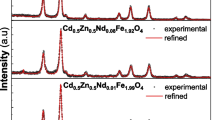Abstract
Preparation of nanoparticles with the desired shape and size by the wet-chemical precipitation process is a challenging task. Thus, the effects of different substitutional impurities such as Al, Cr, Co or Ni on the particle morphology and phase stability of goethite have been investigated. Goethite is prepared by air oxidation of Fe(OH)2 · xH2O gel under near neutral conditions. Below certain concentration levels of dopants (Al3+ ≤ 10; Cr3+ ≤ 5; Co2+ ≤ 10 and Ni2+ ≤ 5 at.%) the samples remained monophasic as revealed by XRD, TEM, and IR studies. Above these levels, the substituents produce traces of secondary phases such as lepidocrocite, spinel ferrite and Mn(OH)n. The goethite structure is stable in spite of the iso- or aliovalent substitutions. The individual additives have divergent influence on the particle morphology; Al3+ and Cr3+ decreases the particle size to <50 nm and aspect ratio (AR) <2. Co-substitution produces slender particles with AR as high as 25. Whereas, Ni2+ does not have any influence on the particle morphology. The attributable factors in morphology control are the increased nucleation rate, restricted growth along needle axes, and the strain induced in the goethite lattice as a result of difference in ionic radii. Maghemite, γ-Fe2O3−δ, particles are obtained from goethite wherein the topotactic conversion renders the retention of the particle morphology of the precursor. Maghemite with substituted impurities showed substantial differences in magnetic properties. Saturation magnetization (σs) and coercivity (H c) go down to very low values due to relaxation of spins on the surface atoms as revealed by Mössbauer spectroscopy. Decrease in coercivity is by way of the presence of diamagnetic ion (Al3+). Whereas, Co-substituted maghemite has enhanced H c as a result of high magnetocrystalline anisotropy accompanied by the shape anisotropy.
Similar content being viewed by others
References
J. H. Adair and E. Suvaci Current Opinion in Colloid and Interface Sci. 5 (2000) 160.
R. Dagani Chem. Eng. News 23 (1992) 18.
G. Bate, in “Ferromagnetic Materials,” edited by E. P. Wohlfarth (North-Hollond, 1980) Vol. 2, Chap. 7.
H. Hibst and E. Schwab, in “Materials Science and Technology,” edited by R. W. Cahn, P. Hassen, and E. J. Kramer (VCH, Weinheim, 1994) Vol. 3B, p. 212.
U. Schwertmann, U. Gasser and H. Sticher Geochimica et Cosmochimica Acta 53 (1989) 1293.
R. M. Cornell and U. Schwertmann, in “The Iron Oxides” (Wiley-VCH, Weinheim, 1996).
C. Sudakar, G. N. Subbanna and T. R. N. Kutty J. Mater. Chem. 12 (2002) 107.
G. N. Subbanna, C. Sudakar and T. R. N. Kutty Mater. Chem. Phys. 78 (2002) 43.
E. Von Meerwall Comput. Phys. Commun. 9 (1975) 117.
A. F. Gualtieri and P. Venturelli American Minerologist 84 (1999) 890.
F. D. Bloss, in “Crystallography and Crystal Chemistry: An Introduction” (Holt, Rinehart and Winston, Inc. Newyork, 1971).
M. Sorescu, D. M. Tarabasanu and L. Diamandescu Appl. Phys. Lett. 72(16) (1998) 2047.
E. De Grave, G. M. Da Costa, L. H Bowen, U. Schwertmann and R. E. Vanderberghe Clays and Clay Minerals 44 (1996) 214.
E. Hartert and O. Glemser A. Elektrochemie 60 (1956) 746.
H. D. Megaw, in “Crystal Structures: A Working Approach” (W.B. Saunders company, London, 1973)
A. C. Scheinost, D. G. Schulze and U. Schwertmann Clays and Clay Minerals 47(2) (1999) 156.
L. Bragg and G. F. Claringbull, in “Crystal Structures of Minerals” (G Bell and Sons, 1965).
B. S. W. Dawson, J. E. Fergussen, A. S. Campbell and E. J. B. Cutler Geoderma 35 (1985) 127.
J. Gerth Geochimica et Cosmochimica Acta 54 (1990) 363.
J. Smith and H. P. Wijn, in “Ferrites” (Philips Tech. Library, 1959).
R. Valenzuela, in “Magnetic Ceramics” (Cambridge University Press, 1994).
E. Schwab and R. J. Veitch IEEE Trans on MAG. 24(2) (1988) 1883.
K. Sumiya and T. Matsumoto J. Phys. Chem. Solids 40 (1979) 1097.
M. C. Dend and T. S. Chin Jpn. J. Appl. Phys. 30 (1991) L1276.
Author information
Authors and Affiliations
Corresponding author
Rights and permissions
About this article
Cite this article
Sudakar, C., Subbanna, G.N. & Kutty, T.R.N. Effect of cationic substituents on particle morphology of goethite and the magnetic properties of maghemite derived from substituted goethite. Journal of Materials Science 39, 4271–4286 (2004). https://doi.org/10.1023/B:JMSC.0000033409.26766.62
Issue Date:
DOI: https://doi.org/10.1023/B:JMSC.0000033409.26766.62




